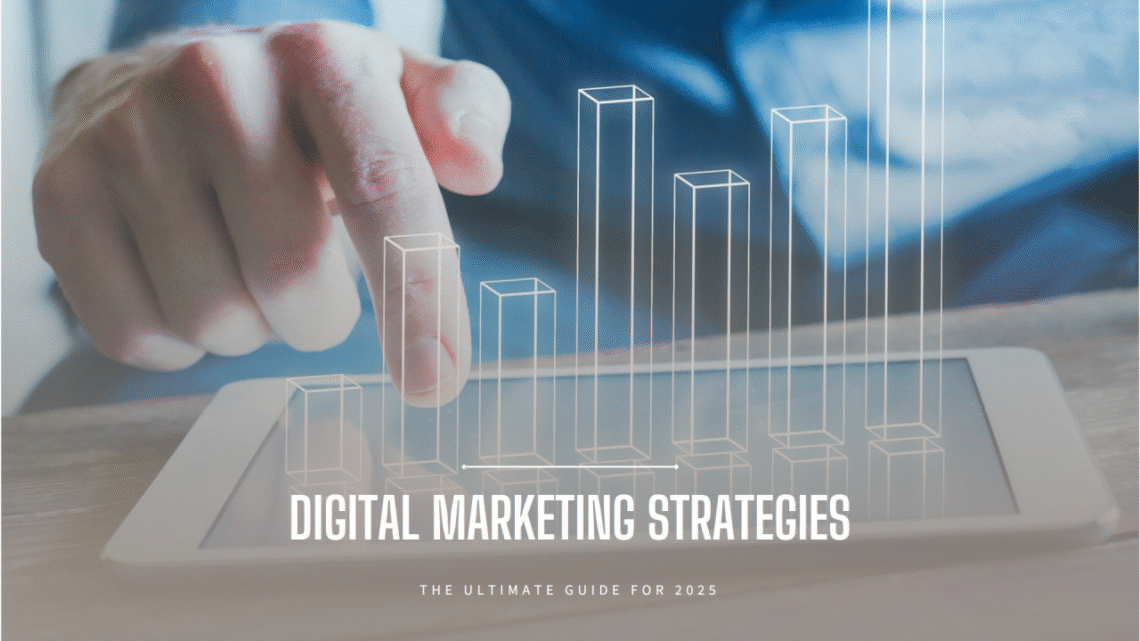As we move into 2025, digital marketing continues to evolve at a rapid pace. New technologies, changing consumer behavior, and increasing competition mean that staying ahead requires an adaptive, innovative approach. To help your business thrive, it’s crucial to understand the latest trends and strategies that can give you a competitive edge. Here’s a guide to the digital marketing strategies that will dominate in 2025 and how you can leverage them to stay ahead of your competition.
1. Leverage Artificial Intelligence (AI) for Personalization
In 2025, AI will be more integrated than ever into digital marketing strategies. Personalization powered by AI will allow you to create highly tailored experiences for your audience, boosting engagement and conversion rates. By analyzing customer data and behavior, AI can deliver personalized content, product recommendations, and targeted ads at scale.
How to Implement AI:
-
Personalized Email Campaigns: Use AI to analyze subscriber data and send tailored emails based on their preferences and behaviors.
-
Dynamic Content: Create dynamic landing pages and content that change based on the user’s past interactions with your site.
-
Chatbots: Implement AI-driven chatbots for real-time, personalized customer support that can increase satisfaction and conversion rates.
2. Embrace Voice Search Optimization
With the growing popularity of voice assistants like Google Assistant, Siri, and Alexa, voice search is becoming increasingly important in 2025. As more people use voice commands to search for products, services, and information, optimizing for voice search will be a game-changer for SEO.
How to Optimize for Voice Search:
-
Use Natural Language: People tend to ask questions in a more conversational tone when using voice search. Incorporate natural, long-tail keywords and question-based phrases into your content.
-
Focus on Local SEO: Since many voice searches are location-based (e.g., “Where is the nearest coffee shop?”), ensuring your business is optimized for local SEO will help you rank higher in local voice searches.
-
Featured Snippets: Voice assistants often pull information from featured snippets. Optimize your content to appear in these snippets by providing concise answers to common questions.
3. Invest in Video Marketing
Video content has been growing in importance, and by 2025, it will be an essential part of any successful digital marketing strategy. From product demonstrations to behind-the-scenes footage and educational content, video allows businesses to connect with their audience in a more personal and engaging way.
How to Use Video Marketing Effectively:
-
Live Streaming: Engage with your audience in real-time through live streaming events, product launches, and Q&A sessions. Live videos foster a sense of urgency and exclusivity, which can drive higher engagement.
-
Short-Form Videos: Platforms like TikTok, Instagram Reels, and YouTube Shorts are dominating the social media landscape. Create quick, engaging content that catches the audience’s attention within the first few seconds.
-
Interactive Videos: Use interactive elements in your videos, such as clickable product links or polls, to boost engagement and enhance the user experience.
4. Focus on Social Commerce
Social media is no longer just a platform for brand awareness and engagement. In 2025, social commerce will take center stage as platforms like Instagram, Facebook, and TikTok integrate shopping features directly into their apps. This allows users to browse, shop, and make purchases without ever leaving the social media platform.
How to Capitalize on Social Commerce:
-
Shoppable Posts: Set up your social media accounts to feature direct shopping options, making it easy for followers to purchase products directly from your posts.
-
Collaborations with Influencers: Partner with influencers who align with your brand to promote products and drive traffic to your online store.
-
Augmented Reality (AR): Integrate AR features on social media to allow customers to virtually try out products (e.g., makeup, clothing, or furniture), enhancing their shopping experience.
5. Incorporate Data-Driven Marketing
In 2025, data will continue to be the backbone of successful digital marketing campaigns. By utilizing data analytics, businesses can gain insights into consumer behavior, measure the effectiveness of marketing efforts, and make more informed decisions.
How to Use Data-Driven Marketing:
-
Customer Segmentation: Use data to segment your audience based on demographics, behaviors, and purchasing habits, allowing for more targeted campaigns.
-
Predictive Analytics: Leverage AI and machine learning to predict customer behavior and trends, allowing you to create proactive marketing strategies.
-
A/B Testing: Continuously test your campaigns, landing pages, and advertisements to see what resonates best with your audience. Optimize based on these insights.
6. Adopt Influencer and Micro-Influencer Marketing
In 2025, influencer marketing will continue to be a major player in digital marketing, but there will be a shift toward micro-influencers. These influencers typically have smaller, but highly engaged, audiences, which can lead to more authentic and impactful collaborations.
How to Leverage Influencer Marketing:
-
Partner with Micro-Influencers: Work with influencers who have a niche but loyal following to promote your products. Their followers are more likely to trust their recommendations and convert.
-
Authenticity Matters: Focus on building genuine relationships with influencers who align with your brand values, rather than opting for influencers with the highest follower count.
-
Track ROI: Measure the effectiveness of influencer partnerships by tracking sales, engagement, and brand sentiment.
7. Utilize Augmented Reality (AR) and Virtual Reality (VR)
As technology advances, AR and VR are becoming more accessible for marketing purposes. These technologies provide immersive, interactive experiences that can significantly enhance product visualization, customer engagement, and brand storytelling.
How to Implement AR and VR:
-
Virtual Try-Ons: Allow customers to virtually try on products like clothing, makeup, or eyewear using AR technology.
-
Immersive Experiences: Use VR to create immersive brand experiences or product demonstrations, offering customers a unique way to interact with your offerings.
-
Enhanced Ads: Incorporate AR into your advertising campaigns to create interactive, engaging ads that stand out from traditional formats.
8. Optimize for Sustainability
Sustainability is a key concern for consumers in 2025, and brands that demonstrate a commitment to environmental responsibility will have a competitive edge. Consumers are increasingly demanding transparency in how brands operate, from sourcing materials to packaging choices.
How to Incorporate Sustainability:
-
Promote Eco-Friendly Products: Highlight products that are sustainable, ethically sourced, or have a positive impact on the environment.
-
Eco-Friendly Packaging: Adopt sustainable packaging solutions and communicate this to your customers.
-
Social Responsibility: Engage in social and environmental causes, showcasing your commitment to sustainability through content and campaigns.
9. Optimize User Experience (UX) and Website Performance
User experience (UX) will continue to be a major factor in both customer satisfaction and SEO rankings. In 2025, businesses need to ensure their websites are not only visually appealing but also fast, easy to navigate, and mobile-optimized.
How to Enhance UX:
-
Responsive Design: Ensure your website is mobile-friendly, as more people are shopping on their phones.
-
Fast Loading Times: Optimize your website’s speed to reduce bounce rates and improve user satisfaction.
-
Clear Call-to-Actions: Make it easy for users to navigate your site with clear and compelling calls-to-action (CTAs).
Conclusion
Digital marketing in 2025 will be defined by a blend of advanced technologies, data-driven decisions, and customer-centric strategies. By embracing AI for personalization, optimizing for voice search, and leveraging new technologies like AR and VR, you can stay ahead of the competition and deliver exceptional experiences to your customers. The key to success will be adapting to these trends, continuously optimizing your strategies, and staying agile as the digital landscape evolves.




